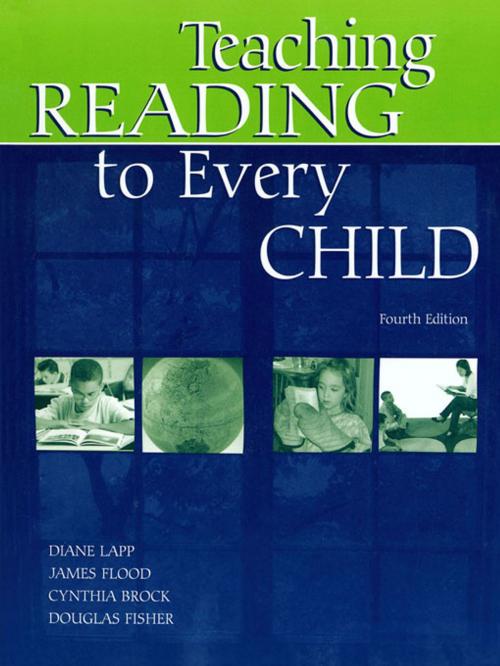Teaching Reading to Every Child
Nonfiction, Reference & Language, Education & Teaching, Teaching, Teaching Methods| Author: | Diane Lapp, James Flood, Cynthia H. Brock, Douglas Fisher | ISBN: | 9781136756146 |
| Publisher: | Taylor and Francis | Publication: | June 17, 2013 |
| Imprint: | Routledge | Language: | English |
| Author: | Diane Lapp, James Flood, Cynthia H. Brock, Douglas Fisher |
| ISBN: | 9781136756146 |
| Publisher: | Taylor and Francis |
| Publication: | June 17, 2013 |
| Imprint: | Routledge |
| Language: | English |
This popular text, now in its Fourth Edition, introduces pre-service and in-service teachers to the most current theories and methods for teaching literacy to children in elementary schools. The methods presented are based on scientific findings that have been tested in many classrooms. A wealth of examples, hands-on activities, and classroom vignettes--including lesson plans, assessments, lists of children's literature books to fiction and nonfiction texts, and more--illustrate the methods and bring them to life.The text highlights the importance of teaching EVERY child to become competent in all of the nuances and complexities of reading, writing, and speaking.
The value of reflection and peer discussion in learning to expand their students' literacies is emphasized. Readers are encouraged to reflect on their own experiences with reading and teaching throughout their lifetimes--experiences that will serve well in learning to teach reading. "Your Turn" boxes invite readers to think about their views of the material presented, and to talk with colleagues and teachers about their "best ways" of learning this new information. "Did You Notice?" boxes engage readers in observation and analysis of methods and classroom situations discussed in the text. Teachers' stories serve as models of successful teaching and to draw readers into professional dialogue about the ideas and questions raised. End-of-chapter questions and activities provide additional opportunities for reflection and discussion. All of these pedagogical features help readers expand and refine their knowledge in the most positive ways.
Topics covered in Teaching Reading to Every Child, Fourth Edition:
*Getting to Know Your Students as Literacy Learners;
*Looking Inside Classrooms: Organizing Instruction;
*Assessing Reading Achievement;
*The Importance of Oral Language in Developing Literacy;
*Word Identification Strategies: Pathways to Comprehension;
*Vocabulary Development;
*Comprehension Instruction: Strategies At Work;
*Content Area Learning;
*What the Teacher Needs to Know to Enable Students' Text Comprehension;
*Writing: Teaching Students to Encode and Compose;
*Discovering the World Through Literature;
*Technology and Media in Reading;
*Teaching Reading to Students Who Are Learning English;
*All Students are Special: Some Need Supplemental Supports and Services to Be Successful; and
*Historical Perspectives on Reading and Reading Instruction.
New in the Fourth Edition:
*A new chapter on technology with state-of-the-art applications;
*A new chapter with the most up-to-date information on how vocabulary is learned and on how it is best taught, responding to the national renewed interest in vocabulary instruction;
*A new section on Readers/Writer's workshop with a focus on supporting student inquiry and exploration of multiple genres;
*A more comprehensive chapter on literature instruction and the role of literature in the reading program with examples that support students' multigenre responses;
*A discussion of literary theories with examples for classroom implementation;
*Broader coverage of the phases of reading development from the pre-alphabetic stage to the full alphabetic stage;
*A more inclusive chapter on writing instruction; and
*A thoroughly revised chapter on teaching reading to students who are learning English, including extensive information on assessment and evaluation.
This popular text, now in its Fourth Edition, introduces pre-service and in-service teachers to the most current theories and methods for teaching literacy to children in elementary schools. The methods presented are based on scientific findings that have been tested in many classrooms. A wealth of examples, hands-on activities, and classroom vignettes--including lesson plans, assessments, lists of children's literature books to fiction and nonfiction texts, and more--illustrate the methods and bring them to life.The text highlights the importance of teaching EVERY child to become competent in all of the nuances and complexities of reading, writing, and speaking.
The value of reflection and peer discussion in learning to expand their students' literacies is emphasized. Readers are encouraged to reflect on their own experiences with reading and teaching throughout their lifetimes--experiences that will serve well in learning to teach reading. "Your Turn" boxes invite readers to think about their views of the material presented, and to talk with colleagues and teachers about their "best ways" of learning this new information. "Did You Notice?" boxes engage readers in observation and analysis of methods and classroom situations discussed in the text. Teachers' stories serve as models of successful teaching and to draw readers into professional dialogue about the ideas and questions raised. End-of-chapter questions and activities provide additional opportunities for reflection and discussion. All of these pedagogical features help readers expand and refine their knowledge in the most positive ways.
Topics covered in Teaching Reading to Every Child, Fourth Edition:
*Getting to Know Your Students as Literacy Learners;
*Looking Inside Classrooms: Organizing Instruction;
*Assessing Reading Achievement;
*The Importance of Oral Language in Developing Literacy;
*Word Identification Strategies: Pathways to Comprehension;
*Vocabulary Development;
*Comprehension Instruction: Strategies At Work;
*Content Area Learning;
*What the Teacher Needs to Know to Enable Students' Text Comprehension;
*Writing: Teaching Students to Encode and Compose;
*Discovering the World Through Literature;
*Technology and Media in Reading;
*Teaching Reading to Students Who Are Learning English;
*All Students are Special: Some Need Supplemental Supports and Services to Be Successful; and
*Historical Perspectives on Reading and Reading Instruction.
New in the Fourth Edition:
*A new chapter on technology with state-of-the-art applications;
*A new chapter with the most up-to-date information on how vocabulary is learned and on how it is best taught, responding to the national renewed interest in vocabulary instruction;
*A new section on Readers/Writer's workshop with a focus on supporting student inquiry and exploration of multiple genres;
*A more comprehensive chapter on literature instruction and the role of literature in the reading program with examples that support students' multigenre responses;
*A discussion of literary theories with examples for classroom implementation;
*Broader coverage of the phases of reading development from the pre-alphabetic stage to the full alphabetic stage;
*A more inclusive chapter on writing instruction; and
*A thoroughly revised chapter on teaching reading to students who are learning English, including extensive information on assessment and evaluation.















